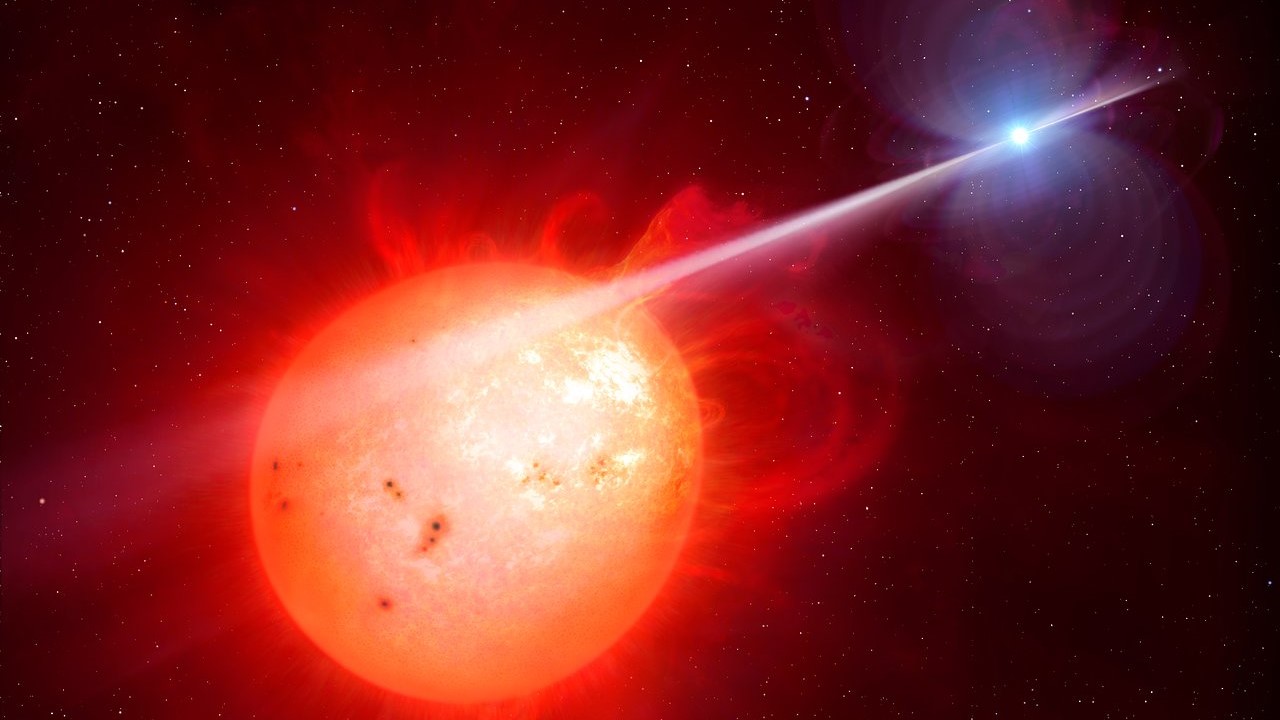Fast-spinning white dwarf pulsar, the 2nd we've ever discovered, sheds light on how stars evolve
The white dwarf pulsar spins 300 times faster than Earth and could help reveal how these rare objects generate powerful magnetic fields.

Astronomers have discovered what is only the second example of a white dwarf pulsar.
The rare stellar remnant is spinning rapidly, and as it does so, it lashes powerful beams of electrical particles and radiation at a red dwarf companion star causing the whole system to dramatically fade and brighten over regular periods.
This pulsar activity is believed to be driven by strong magnetic fields, but scientists aren't sure what causes them. One explanation is a model that suggests white dwarfs have dynamos in their core like that of Earth, which generates its magnetosphere, albeit a much more powerful version. Studying the system could confirm this mechanism and could also grant scientists new insights into stellar evolution.
"The origin of magnetic fields is a big open question in many fields of astronomy, and this is particularly true for white dwarf stars," University of Warwick Department of Physics researcher Ingrid Pelisoli said in a statement. "The magnetic fields in white dwarfs can be more than a million times stronger than the magnetic field of the sun, and the dynamo model helps to explain why. The discovery of J1912−4410 provided a critical step forward in this field."
Related: Black hole shreds star in a cosmic feeding frenzy that has astronomers thrilled
White dwarfs form when stars with masses similar to that of the sun and up to around seven times greater run out of nuclear fuel, and their cores can no longer support themselves against gravitational collapse.
As the stellar cores collapse, these stars shed their outer shell of material which swells out to as great as 100 times the width of the progenitor star. This is known as the red giant phase. The core cools over millions of years as this out shell material spreads out and disperses, leaving behind a stellar remnant called a white dwarf.
Get the Space.com Newsletter
Breaking space news, the latest updates on rocket launches, skywatching events and more!
The sun will undergo this process in around 4.5 billion years, swelling out to around the orbit of Mars, consuming the inner planets, including Earth. Our star will then end its life as a smoldering white dwarf in a dying solar system.
Some white dwarfs find themselves in systems that remain dynamic even after the stellar death throes that create them, especially when they have a companion star. An example of this is the newly detected white dwarf pulsar, J191213.72–441045.1 (J1912–4410), the second system of its type to be found after the discovery of AR Scorpii (AR Sco) in 2016
Located around 773 light-years from our solar system, this white dwarf pulsar has a mass approximately that of the sun crammed into a width around that of Earth. It is spinning around 300 times faster than our planet. Just a teaspoon of material from this white dwarf would weigh 15 tonnes, about four times as heavy as a hippo. White dwarfs lose heat as they age, and the relatively cool temperature of this J1912−4410 indicates that it has an advanced age.
Finding a rare white dwarf pulsar
The team discovered J1912–4410 by searching data delivered by various astronomical surveys for systems with characteristics similar to AR Sco. Potential candidates were followed up with ULTRACAM, an ultra-fast camera capable of taking 500 pictures a second. This makes it perfect for capturing some of the most rapid astronomical events and thus detecting the very fast light variations expected of white dwarf pulsars.
The team found a couple of dozen possible candidates but only one exhibited very similar light variations to AR Sco, sending radio and X-ray signals in the direction of Earth every few seconds.
"This confirmed that there are more white dwarf pulsars out there, as predicted by previous models," Pelisoli said.
"There were other predictions made by the dynamo model, which were confirmed by the discovery of J1912−4410. Due to their old age, the white dwarfs in the pulsar system should be cool. Their companions should be close enough that the gravitational pull of the white dwarf was in the past strong enough to capture mass from the companion, and this causes them to be fast spinning."
All of those predictions were confirmed by J1912–4410, with the white dwarf having a temperature below 23,000 degrees Fahrenheit (13,000 degrees Celsius) which is much cooler than the average white dwarf temperature of around over 180,000 degrees Fahrenheit (100,000 degrees Celsius).
The team also found J1912–4410 spins on its axis once every five minutes, and the gravitational pull of the white dwarf has a strong effect on the companion star, also in line with what the scientists expected to see.
"This research is an excellent demonstration that science works — we can make predictions and put them to the test, and that is how any science progresses," Pelisoli added.
The research was published on June 15 in the journal Nature Astronomy.
Follow us on Twitter @Spacedotcom or on Facebook.
Join our Space Forums to keep talking space on the latest missions, night sky and more! And if you have a news tip, correction or comment, let us know at: community@space.com.

Robert Lea is a science journalist in the U.K. whose articles have been published in Physics World, New Scientist, Astronomy Magazine, All About Space, Newsweek and ZME Science. He also writes about science communication for Elsevier and the European Journal of Physics. Rob holds a bachelor of science degree in physics and astronomy from the U.K.’s Open University. Follow him on Twitter @sciencef1rst.









